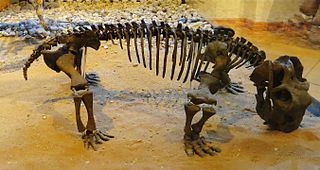Related Research Articles
The Mesozoic Era is an interval of geological time from about 252 to 66 million years ago. It is also called the Age of Reptiles and the Age of Conifers.

The Permian–Triassic extinction event, also known as the P–Tr extinction, the P–T extinction, the End-Permian Extinction, and colloquially as the Great Dying, formed the boundary between the Permian and Triassic geologic periods, as well as between the Paleozoic and Mesozoic eras, approximately 252 million years ago. It is the Earth's most severe known extinction event, with up to 96% of all marine species and 70% of terrestrial vertebrate species becoming extinct. It was the largest known mass extinction of insects. Some 57% of all biological families and 83% of all genera became extinct.

The Triassic is a geologic period and system which spans 50.6 million years from the end of the Permian Period 251.9 million years ago (Mya), to the beginning of the Jurassic Period 201.3 Mya. The Triassic is the first and shortest period of the Mesozoic Era. Both the start and end of the period are marked by major extinction events. The Triassic period is subdivided into three epochs: Early Triassic, Middle Triassic and Late Triassic.

The Triassic–Jurassic (Tr-J) extinction event, sometimes called the end-Triassic extinction, marks the boundary between the Triassic and Jurassic periods, 201.3 million years ago, and is one of the major extinction events of the Phanerozoic eon, profoundly affecting life on land and in the oceans. In the seas, a whole class (conodonts) and 23–34% of marine genera disappeared. On land, all archosauromorphs other than crocodylomorphs, pterosaurs, and dinosaurs went extinct; some of the groups which died out were previously abundant, such as aetosaurs, phytosaurs, and rauisuchids. Some remaining therapsids and many of the large temnospondyl amphibians had gone extinct prior to the Jurassic as well. However, there is still much uncertainty regarding a connection between the Tr-J boundary and terrestrial vertebrates, due to a paucity of terrestrial fossils from the Rhaetian period of the Triassic.

Therapsida is a major group of eupelycosaurian synapsids that includes mammals and their ancestors. Many of the traits today seen as unique to mammals had their origin within early therapsids, including limbs that were oriented more underneath the body, as opposed to the sprawling posture of many reptiles and salamanders. The earliest fossil attributed to Therapsida is Tetraceratops insignis from the Lower Permian.

The Tipulomorpha are an infraorder of Nematocera, containing the crane flies, a very large group, and allied families.

The Bibionomorpha are an infraorder of the suborder Nematocera. One of its constituent families, the Anisopodidae, is the presumed sister taxon to the entire suborder Brachycera. Several of the remaining families in the infraorder are former subfamilies of the Mycetophilidae, which has been recently subdivided. The family Axymyiidae has recently been removed from the Bibionomorpha to its own infraorder Axymyiomorpha.

Herrerasauridae is a family of carnivorous basal saurischian dinosaurs. They are among the oldest known dinosaurs, first appearing in the fossil record around 233.23 million years ago, before becoming extinct by the end of the Triassic period. Herrerasaurids were relatively small-sized dinosaurs, normally not more than 4 metres (13 ft) long, although the holotype specimen of "Frenguellisaurus ischigualastensis" is thought to have reached around 6 meters long. The best known representatives of this group are from South America, where they were first discovered in the 1930s in relation to Staurikosaurus and 1960s in relation to Herrerasaurus. A nearly complete skeleton of Herrerasaurus ischigulastensis was discovered in the Ischigualasto Formation in San Juan, Argentina, in 1988. Less complete possible herrerasaurids have been found in North America, and they may have inhabited other continents as well.

The Early Jurassic epoch is the earliest of three epochs of the Jurassic period. The Early Jurassic starts immediately after the Triassic-Jurassic extinction event, 201.3 Ma, and ends at the start of the Middle Jurassic 174.1 Ma.

Lystrosaurus was a herbivorous genus of dicynodont therapsids from the late Permian and Early Triassic epochs. It lived in what is now Antarctica, India, China, Mongolia, European Russia and South Africa. Four to six species are currently recognized, although from the 1930s to 1970s the number of species was thought to be much higher. They ranged in size from that of a small dog to 2.5 meters long.

The Early Triassic is the first of three epochs of the Triassic Period of the geologic timescale. It spans the time between 251.902 Ma and 247.2 Ma. Rocks from this epoch are collectively known as the Lower Triassic series, which is a unit in chronostratigraphy.

In the geologic timescale, the Middle Triassic is the second of three epochs of the Triassic period or the middle of three series in which the Triassic system is divided in chronostratigraphy. The Middle Triassic spans the time between 247.2 Ma and 237 Ma. It is preceded by the Early Triassic epoch and followed by the Late Triassic epoch. The Middle Triassic is divided into the Anisian and Ladinian ages or stages.
.

The Induan is the first age of the Early Triassic epoch in the geologic timescale, or the lowest stage of the Lower Triassic series in chronostratigraphy. It spans the time between 251.902 Ma and 251.2 Ma. The Induan is sometimes divided into the Griesbachian and the Dienerian subages or substages. The Induan is preceded by the Changhsingian and is followed by the Olenekian.
Eucoelophysis is a genus of dinosauriform from the Late Triassic (Norian) period Chinle Formation of New Mexico. It was assumed to be a coelophysid upon description, but a study by Nesbitt et al. found that it was actually a close relative of Silesaurus, which was independently supported by Ezcurra (2006), who found it to be the sister group to Dinosauria, and Silesaurus as the next most basal taxon.

Camposaurus is a coelophysoid dinosaur genus from the Norian stage of the Late Triassic period of North America. The pertinent fossil remains date back to the early to middle Norian stage, and is widely regarded as the oldest known neotheropod.
Technosaurus is an extinct genus of Late Triassic dinosauriform, from the Late Triassic Bull Canyon Formation of Texas, United States.

Dinosauromorpha is a clade of avemetatarsalian archosaurs that includes the Dinosauria (dinosaurs) and some of their close relatives. It was originally defined to include dinosauriforms and lagerpetids, with later formulations specifically excluding pterosaurs from the group. Birds are the only dinosauromorphs which survive to the present day.

Protorosauria is an extinct, possibly polyphyletic, group of archosauromorph reptiles from the latest Permian to the early Late Triassic of Asia, Europe, North America. It was named by the English anatomist and paleontologist Thomas Henry Huxley in 1871 as an order. Other names which were once considered equivalent to Protorosauria include Prolacertiformes and Prolacertilia.

Dracohors is a clade of dinosauriform archosaurs that includes dinosaurs and silesaurids. The oldest known dracohorsian is Asilisaurus, dating to about 245 million years ago in the Anisian age of the middle Triassic period. According to Andrea Cau (2018), the synapomorphies of dracohorsians are:
The anterior tympanic recess, the axial epipophyses, the centrodiapophyseal laminae in the presacral vertebrae, the relative size enlargement of the postacetabular process of ilium, the elongation of the pubis, the proximal sulcus and the reduction of the ligament tuber in the femoral head, and the further reduction in length of the fourth metatarsal and toe compared to the third.
References
- ↑ Krystyna Zawidzka (1971). "Triassic holothurian sclerites from Tatra Mountains" (PDF). Acta Palaeontologica Polonica . 16 (4): 429–450.
| This article about a prehistoric sea cucumber is a stub. You can help Wikipedia by expanding it. |